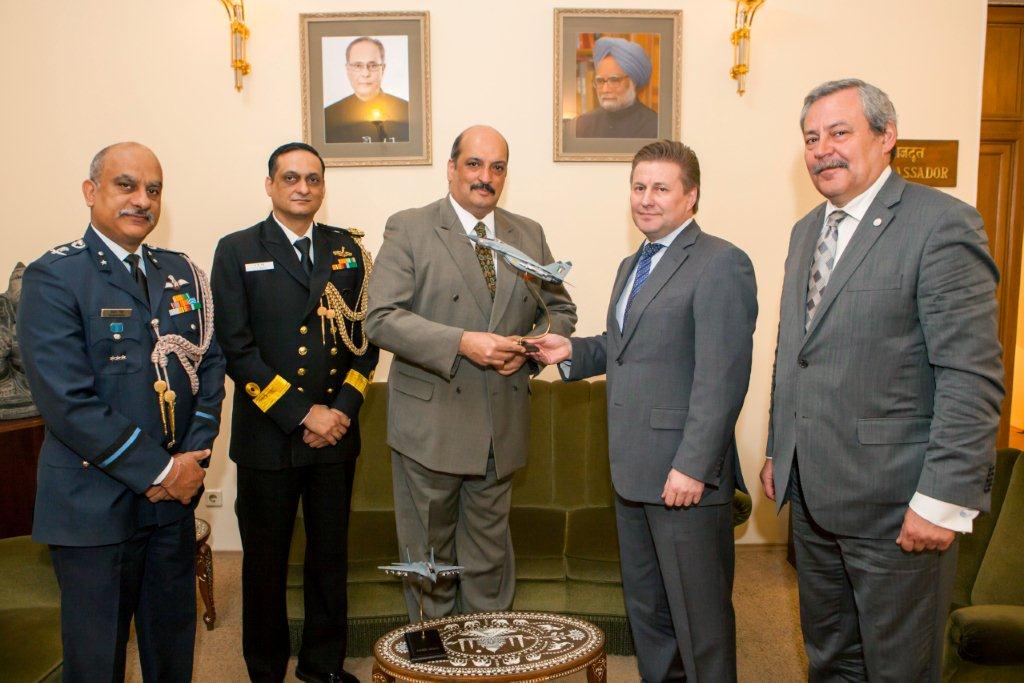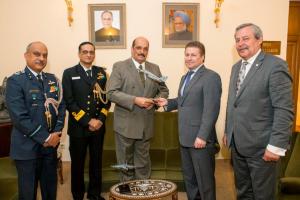MIG-21:: Flying coffin??? is it.... lets compare it.... with f-16, f-104 , mirage-iii , and lightening....
On December 12, 1971, at the height of the India-Pakistan war, one of the most awaited events in aviation history took place. Two MiG-21 fighters of the Indian Air Force's No.47 squadron, providing air patrol to sensitive installations in western India, intercepted a couple of Pakistan Air Force F-104 Starfighters approaching the city of Jamnagar. The MiGs drew first blood – while one Starfighter managed to flee in the direction of Pakistan, the other one was shot down over the Gulf of Kutch.
During the war the MiG-21s played a crucial role in giving the IAF air superiority that played a huge part in India's victory. Military analyst Edward Coggins writes in Wings That Stay On: The Role of Fighter Aircraft in War that by the time the hostilities came to an end, the IAF MiG-21s had claimed four PAF F-104s, two PAF F6, one PAF North American F-86 Sabre and one PAF Lockheed C-130 Hercules. The Russian fighter had clearly won the much anticipated air combat between the MiG-21 and the F-104, he writes.
But that's not where the story ends. Tom Cooper writes in Arab MiG-19 and MiG-21 Units in Combat: "Because of the formidable performance of the MiG-21s several nations, including Iraq, approached India for MiG-21 pilot training. By the early 1970s, more than 120 Iraqi pilots were being trained by the Indian Air Force."
50 years of combat
The MiG-21 has the distinction of holding a number of aviation records, including the most produced jet aircraft in aviation history, the most produced combat aircraft since WWII, and the longest production run of a combat aircraft. Over 11,000 MiG-21 aircraft, derivatives and copies have been built since 1959 and have served with 50 air forces. Because of its low cost and ease of maintenance, even by poor countries, it came to be known as the "people's fighter".
Today, in the age of stealth aircraft, over 20 countries continue to operate this plucky Russian fighter. Namibia became the most recent country to induct the interceptor in its air force when it acquired two MiG-21s in March 2005, proving that age is no handicap for a good plane.
No fighter can survive this long and in so many air forces if it is not combat worthy. For comparison look at the MiG-21's Cold War rivals – the F-104, the French Mirage III and British Lightning are now seen only in museums or airplane boneyards.
Crash rate: MiG-21 vs Rivals
Of the 793 MiG-21s inducted into IAF since 1963, well over 350 have been lost in accidents, killing 170 pilots. However, labelling it a "flying coffin" is plain wrong. This is being done by misinformed (or incompetent) and under-pressure journalists. In fact, during my days at India Today magazine we stopped using such expressions when confronted with facts. The then IAF chief called us and said our cavalier use of the term "flying coffin" was causing trauma to the families of pilots flying the aircraft. He supplied us data to show the MiG-21 wasn't a dangerous aircraft at all.
Former Air Chief Marshal A.Y. Tipnis has said the higher number of crashes (not to be confused with the crash rate) is because the "MiG-21s are most in numbers and in use operationally".
Now let's take a look at the MiG-21's chief rivals. Between 1960 and 1987, the German air force flew nearly a thousand F-104s and lost 292. In a similar time frame, the Canadian air force lost over 100 of their 200 Starfighters. The highly experienced pilots of the British air force didn't fare any better, crashing over a hundred of their 300 Lightnings over a period of 25 years.
In a report prepared for the US Air Force School of Aerospace Medicine, C.J. Knapp and R. Johnson revealed that during a 19-year period from 1975-93 there were 190 Class A – or major – mishaps involving 204 F-16s and 217 aircrew.
Compared to this, India's MiG-21 has a much better record.
Causes of crashes
As we have seen, 20 air forces around the world continue to stick with the MiG-21. MiGs are not tumbling out of the air in Ukraine, Czech Republic, Algeria, Finland or Bulgaria. China has cloned and flies over 700 of these fighters and has supplied 150 to Pakistan. Among these countries, India alone trains its pilots to Western standards. This involves intense peacetime training, which means potentially more accidents. A former air force chief has gone on record that he would rather lose pilots during training than during war.
But several other factors are involved in accidents. Let's see which ones are directly responsible and which have only a minimal role.
India: A harsh environment
Tropical and crowded, India is an unforgiving environment for any aircraft. The hot air means aircraft engines produce less thrust and the wing produce less lift compared to similar aircraft flying in European skies. Sun baked runways are also known to impact landing safety. These are factors IAF pilots have to live with.
Bird hits are another huge factor in aircraft accidents over India. Most IAF bases are located near populated areas, where birds are a constant menace. It's going to get worse before it gets better.
Economic collapse and spare shortages
It is true the dissolution of the Soviet Union and the chaos that followed played havoc with Russia's command economy. The closure of Russia's armaments factories stopped the free flow of spares from the country. Desperate to keep its main interceptor force flying, the IAF managed to get spares from East European countries, which were cannibalising their MiG-21s for cash.
Russian defence experts, including MiG officials, have blamed these grey market purchases for the IAF's crashes. However, the argument has no legs because firstly, the IAF is one of the world's most professional fighting forces; it will not put its pilots' life at risk by such reckless purchases. Two, it was buying genuine spares from the standardised air forces of the former Warsaw Pact. The Russians backtracked when confronted with IAF data. However, it remains true that spare parts made by HAL are not as good as the Russian ones.
Arrival of modern aircraft in the IAF
The MiG-21s formed the backbone of the IAF in the 1960s and '70s. But the situation changed with the arrival of newer aircraft, which drew the most experienced pilots from the MiG-21 squadrons. There was nothing wrong with it because that's how the system is supposed to work. But the MiG-21 now became the jet that rookie pilots graduated to. In tandem with another factor, it spelled trouble for the IAF.
Training – out of kilter
Despite acquiring its first supersonic jet in 1963, the IAF did not get a jet trainer until 2004 because it took decades for the proposal to make its way through the defence procurement bureaucracy.
For close to 40 years rookie pilots went straight from propeller driven and subsonic trainers to the supersonic MiG-21. At a MAKS air show in Moscow, Russian test-pilot Andrey Shishov described how it felt flying a supersonic jet at 30,000 ft: "At a height of several thousand kilometres, a nine-unit strong G-force means you feel like you weigh nine times more than you really do, so not 75 kilos for example but 600-700 kg."
In an article in Indian Aviation magazine, IAF Wing Commander K.S. Suresh says in air combat manoeuvres, inexperienced pilots flying the MiG-21 have got into trouble without realising it. When the aircraft develops a high rate of descent, it cannot be arrested with the power available. Worse, "there is no protest from the aircraft like severe shudder, wing rocking etc prevalent in other types of aircraft. This gives a feeling of well-being and a number of pilots did not recognise the danger in time to take recovery action or eject".
Essentially, young pilots were pitchforked into an aerial meat grinder, resulting in a high loss rate from peacetime accidents.
Caught in the MiG's crosshairs
More than half a century after its first flight, the MiG-21 packs a lethal punch. At the Cope India exercise held in 2004 at Gwalior, Indian pilots flying MiG-21 Bisons (upgraded with Russian Phazatron radar, Vympel R-73 missiles and the beyond visual range Vympel R-77 air-to-air missiles) blew away the F-15 and the F-16 fighters of the USAF on one-on-one as well as in mixed exercises. The USAF acknowledged the MiG-21 Bisons and Su-30MKIs were tough opponents.
In the next Cope India exercise in 2005 at Kalaikundi, Indian pilots operating the MiG-21s and Sukhois emerged victorious most of the time.
Kargil was another theatre where the MiG-21 showed it was still a threat. The Pakistan Air Force's director of operations during the war acknowledged afterward that the GPS-assisted high-altitude bombing by the MiG-21, MiG-23BN and MiG-27 was a game changer. This is corroborated by aviation historian and author Pushpindar Singh in Himalayan Eagles: ""¦targeting pod imagery observed by IAF pilots in real time showed enemy troops abandoning their positions at the very sound of approaching fighters."
Flying into the sunset?
Bowing to pressure from Parliament after the trial by media, the IAF has announced it will be retiring its entire MiG-21 fleet by 2017, by which time the Indian-built Tejas light combat aircraft would hopefully be ready for combat. But with the Tejas not exactly experiencing beginner's luck, the smart money is on the MiGs flying well into the next decade.



